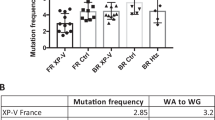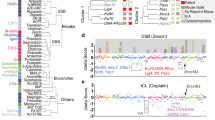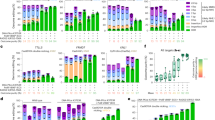Abstract
Somatic hypermutation of immunoglobulin genes occurs at both C·G pairs and A·T pairs. Mutations at C·G pairs are created by activation-induced deaminase (AID)-catalysed deamination of C residues to U residues. Mutations at A·T pairs are probably produced during patch repair of the AID-generated U·G lesion, but they occur through an unknown mechanism. Here, we compare the popular suggestion of nucleotide mispairing through polymerase error with an alternative possibility, mutation through incorporation of dUTP (or another non-canonical nucleotide).
This is a preview of subscription content, access via your institution
Access options
Subscribe to this journal
Receive 12 print issues and online access
$209.00 per year
only $17.42 per issue
Buy this article
- Purchase on Springer Link
- Instant access to full article PDF
Prices may be subject to local taxes which are calculated during checkout




Similar content being viewed by others
References
Burnet, F. M. A modification of Jerne's theory of antibody formation using the concept of clonal selection. Aust. J. Sci. 20, 67–69 (1957).
Lederberg, J. Genes and antibodies. Do antigens bear instructions for antibody specificity or do they select cell lines that arise by mutation? Science 129, 1649–1653 (1959).
Hilschmann, N. & Craig, L. C. Amino acid sequence studies with Bence–Jones proteins. Proc. Natl Acad. Sci. USA 53, 1403–1409 (1965).
Titani, K., Whitley, E., Avogardo, L. & Putnam, F. W. Immunoglobulin structure: partial amino acid sequence of a Bence Jones protein. Science 152, 1513–1516 (1966).
Milstein, C. Variations in amino acid sequence near the disulphide bridges of Bence–Jones proteins. Nature 209, 370–373 (1966).
Brenner, S. & Milstein, C. Origin of antibody variation. Nature 211, 242–243 (1966).
Speyer, J. F. Mutagenic DNA polymerase. Biochem. Biophys. Res. Commun. 21, 6–8 (1965).
Yanofsky, C., Cox, E. C. & Horn, V. The unusual mutagenic specificity of an E. coli mutator gene. Proc. Natl Acad. Sci. USA 55, 274–281 (1966).
Tonegawa, S. Somatic generation of antibody diversity. Nature 302, 575–581 (1983).
Rajewsky, K. Clonal selection and learning in the antibody system. Nature 381, 751–758 (1996).
Parham, P. (ed.) Somatic hypermutation of immunoglobulin genes. Immunol. Rev. 162, 1–298 (1998).
Ohmori, H. et al. The Y-family of DNA polymerases. Mol. Cell 8, 7–8 (2001).
Neuberger, M. S., Harris, R. S., Di Noia, J. M. & Petersen-Mahrt, S. K. Immunity through DNA deamination. Trends Biochem. Sci. 28, 305–312 (2003).
Zeng, X. et al. DNA polymerase η is an A·T mutator in somatic hypermutation of immunoglobulin variable genes. Nature Immunol. 2, 537–541 (2001).
Faili, A. et al. DNA polymerase η is involved in hypermutation occurring during immunoglobulin class switch recombination. J. Exp. Med. 199, 265–270 (2004).
Zeng, X., Negrete, G. A., Kasmer, C., Yang, W. W. & Gearhart, P. J. Absence of DNA polymerase η reveals targeting of C mutations on the nontranscribed strand in immunoglobulin switch regions. J. Exp. Med. 199, 917–924 (2004).
Faili, A. et al. Induction of somatic hypermutation in immunoglobulin genes is dependent on DNA polymerase ι. Nature 419, 944–947 (2002).
Diaz, M., Verkoczy, L. K., Flajnik, M. F. & Klinman, N. R. Decreased frequency of somatic hypermutation and impaired affinity maturation but intact germinal center formation in mice expressing antisense RNA to DNA polymerase ζ. J. Immunol. 167, 327–335 (2001).
Zan, H. et al. The translesion DNA polymerase ζ plays a major role in Ig and BCL-6 somatic hypermutation. Immunity 14, 643–653 (2001).
Simpson, L. J. & Sale, J. E. Rev1 is essential for DNA damage tolerance and non-templated immunoglobulin gene mutation in a vertebrate cell line. EMBO J. 22, 1654–1664 (2003).
Petersen-Mahrt, S. K., Harris, R. S. & Neuberger, M. S. AID mutates E. coli suggesting a DNA deamination mechanism for antibody diversification. Nature 418, 99–104 (2002).
Pham, P., Bransteitter, R., Petruska, J. & Goodman, M. F. Processive AID-catalysed cytosine deamination on single-stranded DNA simulates somatic hypermutation. Nature 424, 103–107 (2003).
Chaudhuri, J. et al. Transcription-targeted DNA deamination by the AID antibody diversification enzyme. Nature 422, 726–730 (2003).
Bransteitter, R., Pham, P., Scharff, M. D. & Goodman, M. F. Activation-induced cytidine deaminase deaminates deoxycytidine on single-stranded DNA but requires the action of RNase. Proc. Natl Acad. Sci. USA 100, 4102–4107 (2003).
Ramiro, A. R., Stavropoulos, P., Jankovic, M. & Nussenzweig, M. C. Transcription enhances AID-mediated cytidine deamination by exposing single-stranded DNA on the nontemplate strand. Nature Immunol. 4, 452–456 (2003).
Sohail, A., Klapacz, J., Samaranayake, M., Ullah, A. & Bhagwat, A. S. Human activation-induced cytidine deaminase causes transcription-dependent, strand-biased C to U deaminations. Nucleic Acids Res. 31, 2990–2994 (2003).
Beale, R. C. et al. Comparison of the differential context-dependence of DNA deamination by APOBEC enzymes: correlation with mutation spectra in vivo. J. Mol. Biol. 337, 585–596 (2004).
Yu, K., Huang, F. T. & Lieber, M. R. DNA substrate length and surrounding sequence affect the activation-induced deaminase activity at cytidine. J. Biol. Chem. 279, 6496–6500 (2004).
Martin, A. et al. Activation-induced cytidine deaminase turns on somatic hypermutation in hybridomas. Nature 415, 802–806 (2002).
Yoshikawa, K. et al. AID enzyme-induced hypermutation in an actively transcribed gene in fibroblasts. Science 296, 2033–2036 (2002).
Di Noia, J. & Neuberger, M. S. Altering the pathway of IgV gene hypermutation by inhibiting uracil DNA glycosylase. Nature 419, 43–48 (2002).
Rada, C. et al. Immunoglobulin isotype switching is inhibited and somatic hypermutation perturbed in UNG-deficient mice. Curr. Biol. 12, 1748–1755 (2002).
Imai, K. et al. Human uracil-DNA glycosylase deficiency associated with profoundly impaired immunoglobulin class-switch recombination. Nature Immunol. 4, 1023–1028 (2003).
Rada, C., Ehrenstein, M. R., Neuberger, M. S. & Milstein, C. Hotspot focusing of somatic hypermutation in MSH2-deficient mice suggests two stages of mutational targeting. Immunity 9, 135–141 (1998).
Phung, Q. H. et al. Increased hypermutation at G and C nucleotides in immunoglobulin variable genes from mice deficient in the MSH2 mismatch repair protein. J. Exp. Med. 187, 1745–1751 (1998).
Frey, S. et al. Mismatch repair deficiency interferes with the accumulation of mutations in chronically stimulated B cells and not with the hypermutation process. Immunity 9, 127–134 (1998).
Muramatsu, M. et al. Class switch recombination and hypermutation require activation-induced cytidine deaminase (AID), a potential RNA editing enzyme. Cell 102, 553–563 (2000).
Revy, P. et al. Activation-induced cytidine deaminase (AID) deficiency causes the autosomal recessive form of the hyper-IgM syndrome (HIGM2). Cell 102, 565–575 (2000).
Wiesendanger, M., Kneitz, B., Edelmann, W. & Scharff, M. D. Somatic hypermutation in MutS homologue (MSH)3-, MSH6-, and MSH3/MSH6-deficient mice reveals a role for the MSH2–MSH6 heterodimer in modulating the base substitution pattern. J. Exp. Med. 191, 579–584 (2000).
Li, Z. B. et al. Examination of Msh6- and Msh3-deficient mice in class switching reveals overlapping and distinct roles of MutS homologues in antibody diversification. J. Exp. Med. 200, 47–59 (2004).
Martomo, S. A., Yang, W. W. & Gearhart, P. J. A role for Msh6 but not Msh3 in somatic hypermutation and class switch recombination. J. Exp. Med. 200, 61–68 (2004).
Bardwell, P. D. et al. Altered somatic hypermutation and reduced class-switch recombination in exonuclease 1-mutant mice. Nature Immunol. 5, 224–229 (2004).
Rada, C., Di Noia, J. M. & Neuberger, M. S. Mismatch recognition and uracil-excision provide complementary paths to both Ig switching and the A·T-focused phase of somatic mutation. Mol. Cell 16, 163–171 (2004).
Steele, E. J., Franklin, A. & Blanden, R. V. Genesis of the strand-biased signature in somatic hypermutation of rearranged immunoglobulin variable genes. Immunol. Cell Biol. 82, 209–218 (2004).
Glassner, B. J., Rasmussen, L. J., Najarian, M. T., Posnick, L. M. & Samson, L. D. Generation of a strong mutator phenotype in yeast by imbalanced base excision repair. Proc. Natl Acad. Sci. USA 95, 9997–10002 (1998).
Matsuda, T., Bebenek, K., Masutani, C., Hanaoka, F. & Kunkel, T. A. Low fidelity DNA synthesis by human DNA polymerase-η. Nature 404, 1011–1013 (2000).
Matsuda, T. et al. Error rate and specificity of human and murine DNA polymerase η. J. Mol. Biol. 312, 335–346 (2001).
Rogozin, I. B., Pavlov, Y. I., Bebenek, K., Matsuda, T. & Kunkel, T. A. Somatic mutation hotspots correlate with DNA polymerase η error spectrum. Nature Immunol. 2, 530–536 (2001).
Pavlov, Y. I. et al. Correlation of somatic hypermutation specificity and A·T base pair substitution errors by DNA polymerase η during copying of a mouse immunoglobulin κ light chain transgene. Proc. Natl Acad. Sci USA 99, 9954–9959 (2002).
McDonald, J. P. et al. 129-derived strains of mice are deficient in DNA polymerase ι and have normal immunoglobulin hypermutation. J. Exp. Med. 198, 635–643 (2003).
Johnson, R. E., Washington, M. T., Haracska, L., Prakash, S. & Prakash, L. Eukaryotic polymerases ι and ζ act sequentially to bypass DNA lesions. Nature 406, 1015–1019 (2000).
Hochhauser, S. J. & Weiss, B. Escherichia coli mutants deficient in deoxyuridine triphosphatase. J. Bacteriol. 134, 157–166 (1978).
Guillet, M. & Boiteux, S. Origin of endogenous DNA abasic sites in Saccharomyces cerevisiae. Mol. Cell. Biol. 23, 8386–8394 (2003).
Tye, B. K., Nyman, P. O., Lehman, I. R., Hochhauser, S. & Weiss, B. Transient accumulation of Okazaki fragments as a result of uracil incorporation into nascent DNA. Proc. Natl Acad. Sci. USA 74, 154–157 (1977).
Gadsden, M. H., McIntosh, E. M., Game, J. C., Wilson, P. J. & Haynes, R. H. dUTP pyrophosphatase is an essential enzyme in Saccharomyces cerevisiae. EMBO J. 12, 4425–4431 (1993).
McIntosh, E. M., Gadsden, M. H. & Haynes, R. H. Transcription of genes encoding enzymes involved in DNA synthesis during the cell cycle of Saccharomyces cerevisiae. Mol. Gen. Genet. 204, 363–366 (1986).
Strahler, J. R. et al. Maturation stage and proliferation-dependent expression of dUTPase in human T cells. Proc. Natl Acad. Sci. USA 90, 4991–4995 (1993).
Ladner, R. D. & Caradonna, S. J. The human dUTPase gene encodes both nuclear and mitochondrial isoforms. Differential expression of the isoforms and characterization of a cDNA encoding the mitochondrial species. J. Biol. Chem. 272, 19072–19080 (1997).
Bertocci, B. et al. Probing immunoglobulin gene hypermutation with microsatellites suggests a nonreplicative short patch DNA synthesis process. Immunity 9, 257–265 (1998).
Faili, A. et al. AID-dependent somatic hypermutation occurs as a DNA single-strand event in the BL2 cell line. Nature Immunol. 3, 815–821 (2002).
Akbari, M. et al. Repair of U·G and U·A in DNA by UNG2-associated repair complexes takes place predominantly by short-patch repair both in proliferating and growth-arrested cells. Nucleic Acids Res. 32, 5486–5498 (2004).
Krokan, H. E., Drablos, F. & Slupphaug, G. Uracil in DNA — occurrence, consequences and repair. Oncogene 21, 8935–8948 (2002).
Pearl, L. H. Structure and function in the uracil-DNA glycosylase superfamily. Mutat. Res. 460, 165–181 (2000).
Nilsen, H. et al. Uracil-DNA glycosylase (UNG)-deficient mice reveal a primary role of the enzyme during DNA replication. Mol. Cell 5, 1059–1065 (2000).
Lebecque, S. G. & Gearhart, P. J. Boundaries of somatic mutation in rearranged immunoglobulin genes: 5′ boundary is near the promoter, and 3′ boundary is approximately 1 kb from V(D)J gene. J. Exp. Med. 172, 1717–1727 (1990).
Milstein, C., Neuberger, M. S. & Staden, R. Both DNA strands of antibody genes are hypermutation targets. Proc. Natl Acad. Sci. USA 95, 8791–8794 (1998).
Harris, R. S. & Liddament, M. T. Retroviral restriction by APOBEC proteins. Nature Rev. Immunol. 4, 868–877 (2004).
Chen, R., Wang, H. & Mansky, L. M. Roles of uracil-DNA glycosylase and dUTPase in virus replication. J. Gen. Virol. 83, 2339–2345 (2002).
Turelli, P., Guiguen, F., Mornex, J. F., Vigne, R. & Querat, G. dUTPase-minus caprine arthritis-encephalitis virus is attenuated for pathogenesis and accumulates G-to-A substitutions. J. Virol. 71, 4522–4530 (1997).
Lerner, D. L. et al. Increased mutation frequency of feline immunodeficiency virus lacking functional deoxyuridine-triphosphatase. Proc. Natl Acad. Sci. USA 92, 7480–7484 (1995).
Liu, M. et al. Reverse transcriptase-mediated tropism switching in Bordetella bacteriophage. Science 295, 2091–2094 (2002).
Boeke, J. D. Evolution: A is for adaptation. Nature 431, 408–409 (2004).
Friedberg, E. C., Walker, G. C. & Siede, W. Deoxyribonucleic acid and mutagenesis (American Society for Microbiology Press, Washington DC, 1995).
Kornberg, A. DNA Replication (Freeman, San Francisco, 1980).
Ludwig, D. L. et al. A murine AP-endonuclease gene-targeted deficiency with post-implantation embryonic progression and ionizing radiation sensitivity. Mutat. Res. 409, 17–29 (1998).
Author information
Authors and Affiliations
Corresponding author
Ethics declarations
Competing interests
The authors declare no competing financial interests.
Related links
Related links
DATABASES
Entrez Gene
Glossary
- ABASIC SITE
-
A site in DNA where a nucleotide base has been removed by cleavage of the glycosidic bond that links the nucleotide base to the deoxyribose-phosphate backbone.
- BASE-EXCISION REPAIR
-
A repair pathway that recognizes and eliminates from DNA particular non-canonical bases (such as deaminated or oxidized bases), replacing them with an appropriate base templated on the opposite strand.
- CLONAL-SELECTION THEORY
-
A theory to account for the specificity of the adaptive humoral immune response, in which unknown processes were assumed to mediate the generation of diverse precursor cells, thereby resulting in the production of antibodies of different specificities. Antigen-mediated selection would then trigger clonal expansion and antibody secretion by those cells that produce a cognate antibody.
- LESION-BYPASS DNA POLYMERASE
-
A DNA polymerase that can synthesize past a lesion (such as an abasic site or a base adduct) in the template strand.
- LOW-FIDELITY DNA POLYMERASES
-
DNA polymerases that have a considerably higher rate of nucleotide misincorporation than the DNA polymerases that carry out normal chromosomal replication of the genome of the cell, so they frequently generate mismatched base pairs.
- MISMATCH REPAIR
-
A repair pathway that recognizes and corrects mismatched base pairs, typically those that arise from errors of chromosomal DNA replication.
- PATCH REPAIR
-
Repair of a DNA lesion by degrading a short patch of DNA on the damaged strand and resynthesizing it using the other strand as a template. The repair usually occurs at a time distinct from that at which the genome is replicated.
- S PHASE
-
(Synthesis phase). The phase of the cell cycle during which the genomic DNA is replicated.
- TRANSITION MUTATIONS
-
Base changes in DNA in which a pyrimidine (C or T) is replaced by another pyrimidine, or a purine (A or G) is replaced by another purine.
- TRANSVERSION MUTATIONS
-
Base changes in DNA in which a pyrimidine (C or T) is replaced by a purine (A or G), or a purine is replaced by a pyrimidine.
- WATSON–CRICK BASE PAIRING
-
The complementary alignment of purine (A or G) and pyrimidine (C, T or U) nucleotides on opposite nucleic-acid strands in pairings (C with G, and A with T or U) that allow maintenance of the double-helical conformation that was proposed by Watson and Crick.
Rights and permissions
About this article
Cite this article
Neuberger, M., Noia, J., Beale, R. et al. Somatic hypermutation at A·T pairs: polymerase error versus dUTP incorporation. Nat Rev Immunol 5, 171–178 (2005). https://doi.org/10.1038/nri1553
Issue Date:
DOI: https://doi.org/10.1038/nri1553
This article is cited by
-
Transcription as a source of genome instability
Nature Reviews Genetics (2012)
-
Stabilised DNA secondary structures with increasing transcription localise hypermutable bases for somatic hypermutation in IGHV3-23
Immunogenetics (2012)
-
Uracil residues dependent on the deaminase AID in immunoglobulin gene variable and switch regions
Nature Immunology (2011)
-
Altered spectrum of somatic hypermutation in common variable immunodeficiency disease characteristic of defective repair of mutations
Immunogenetics (2011)
-
Cellular choreography in the germinal center: new visions from in vivo imaging
Seminars in Immunopathology (2010)



